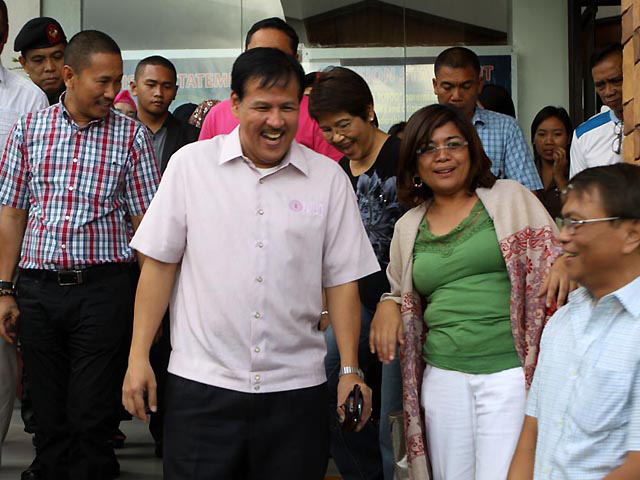Filtered by: Lifestyle
Lifestyle
Jesse Robredo made Naga City 'a happy place'
By YASMIN D. ARQUIZA, GMA News

DILG Sec. Jesse Robredo shares a light moment with Maguindanao Gov. Esmael Mangudadatu (left) and North Cotabato Gov. Emmylou Mendoza (right) after a peace and order council meeting in Kidapawan City on Aug. 13, five days before his plane crashed off Masbate City. Mark Navales
Before he was appointed as head of the Department of Interior and Local Government, Jesse Robredo served as longtime mayor of Naga City until 2010. The author interviewed him in 2009 for a case study on the City Youth Official program, one of Naga City’s many award-winning projects during his term. Excerpts from the report, published as "The Mayor’s Apprentice" by the Galing Pook Foundation, follow. In his book Making the Best Better, Robredo recounts the decrepit state of Naga City when he assumed office in 1988. At 29, he was the youngest city mayor at that time. The medium-sized city had been reduced to third-class status and had a budget deficit of P1 million due to overspending by previous officials. Pornography and illegal gambling were rampant, and 20 percent of the city’s households were classified as squatters. Business was sluggish, resulting in poor tax collection.
The landlocked city posed difficult challenges for economic growth. Its land area of 84.48 square kilometers only had Naga River serving as commercial waterway for small boats. Like many areas in the country, political patronage prevailed, and Robredo faced an uphill battle in realizing the vision of “An Maogmang Lugar” (a happy place).
A pragmatic go-getter, Robredo immediately set to work on two pressing problems: illegal gambling and an inefficient bureaucracy.
“We closed down all nightclubs and seedy joints, most of which were fronts for prostitution and drug dealing,” he wrote. The new mayor wanted to dispel the public’s impression that local officials and the police profited from these establishments.
In addition, Robredo professionalized the operations of city hall. “In contrast to the former administrations where regular hours were not strictly observed, I put in more hours of work than anyone did during the first few months of my term,” he recalled.
Instead of the vindictive practice of replacing local employees with favored supporters, as seen in many government units, Robredo set up “a system based on aptitude and competence” that allowed everyone to prove their worth.
More than 140 national and international awards later, Naga City continues to surprise jaded political observers with its sustained economic and social development. Just 10 years after Robredo became mayor, Naga’s annual growth rate of 6.5 percent was among the most rapid in the country, its per capita income of P174,500 was 42 percent higher than the national average, and it had a lower poverty incidence of 19 percent compared to the Bicol region’s percent. Third degree malnutrition was practically erased from its 3.5 incidence in 1987 to only 0.1 percent in 1998. Government employees take pride in the city’s 72 day care centers that use the Montessori approach to child development. Naga City had 27 barangays and a population of 137,810 in 2000.
Former city youth mayors credit much of the Naga’s success to the example set by Robredo, who has remained unassuming and cheerfully helpful to any visitor in his office. Fiscal Virgilio Balane recalls seeing Mayor Robredo punch his own time card and wear the city hall uniform to show unity with the employees.
In his work as public prosecutor, Balane has kept in mind the image of Robredo seated at the long working table in the mayor’s office, with two rows of chairs on each side. Anyone can go in and present a complaint or request, which would be resolved or granted on the spot; visitors keep advancing in the queue until they get their turn to speak to the mayor, making the process speedy and transparent.
Robredo’s achievements at an early age seem to have rubbed off on former city youth officials who have made their mark in local governance. Like their boss, several former city youth officials became heads of offices at a young age, usually in their late 20s or early 30s.
Lawyer Imee Abardo-Estrada, who served as city youth mayor in 2001 when she was still a Political Science student at Ateneo de Naga, applied as assistant city legal officer in 2008 and bested six others to get the permanent position.
Florencio Mongoso Jr. of the metro Public Employment Service Office helped bring down the unemployment rate of Naga City to 5.8 percent compared to 12 percent at the national level. This was achieved through pre-screening of job applicants for potential employers such as malls and manufacturing companies, training for unskilled laborers, and appropriate livelihood for self-employed individuals.
Nathan Sergio joined Naga City government in 1989 and nurtured the Urban Poor Affairs Office until it became a full-fledged division in 1997. His replacement, Engineer Rolando Campillos, is a former city youth councilor; between them, they have distributed 8,000 home lots in Naga and wiped out most of the informal settlers in the city center.
“Our mantra here is meaningful participation,” says Robredo. By giving the youth enough authority and time to make a significant contribution, he believes that the program will help raise awareness and provide a valuable education in local governance to the city’s youth. “The hope is that after graduation, they will stay in Naga City or work at city hall,” he added.
With the city’s highest official setting the example, employees are obviously motivated to do no less. For instance, Mongoso says it is considered a “mortal sin” to ask another city hall employee to punch one’s timecard, which is a common practice in many local government units and even private offices.
Going by appearances, a visitor might find it difficult to imagine a well-managed local government hiding inside the Naga City hall. Most of its buildings are shabby and the paint is peeling from the walls, if these are painted at all. Some wall clocks and flush toilets don’t work, there’s no water from the tap, and cobwebs peek out of dusty corners.
Robredo gets a little testy when the sorry state of the city hall is pointed out. “We are not concerned with infrastructure na pang-beauty contest,” he says.
Instead, the mayor points out the kilometers of roads his administration has built, the bridges and drainage systems repaired, and other public works projects that have made Naga one of the most business-friendly and livable cities in the country.
“The trade-off is that pangit ang city hall ko,” he admits. Although he has received countless complaints about the city hall, he tells his constituents, “hangga’t hindi nauubos ang para sa inyo, huli na ang city hall. At least, may karapatan kaming sumingil ng buwis dito at hindi namin inaaksaya ang pera.”
The mayor is so famously frugal that he has earned the reputation as “the biggest fan of Manny Pacquiao,” jokingly relates Fiscal Balane, rolling his hands into two tight fists.
Robredo doesn’t mind the ribbing. He mentions a city in Bicol that borrowed P90 million to build a new city hall, and says he would never do that as “it’s not consistent with my values.”
Last August 18, Robredo died in a plane crash off the waters of Masbate province. He was 54 years old.
Find out your candidates' profile
Find the latest news
Find out individual candidate platforms
Choose your candidates and print out your selection.
Voter Demographics
More Videos
Most Popular





